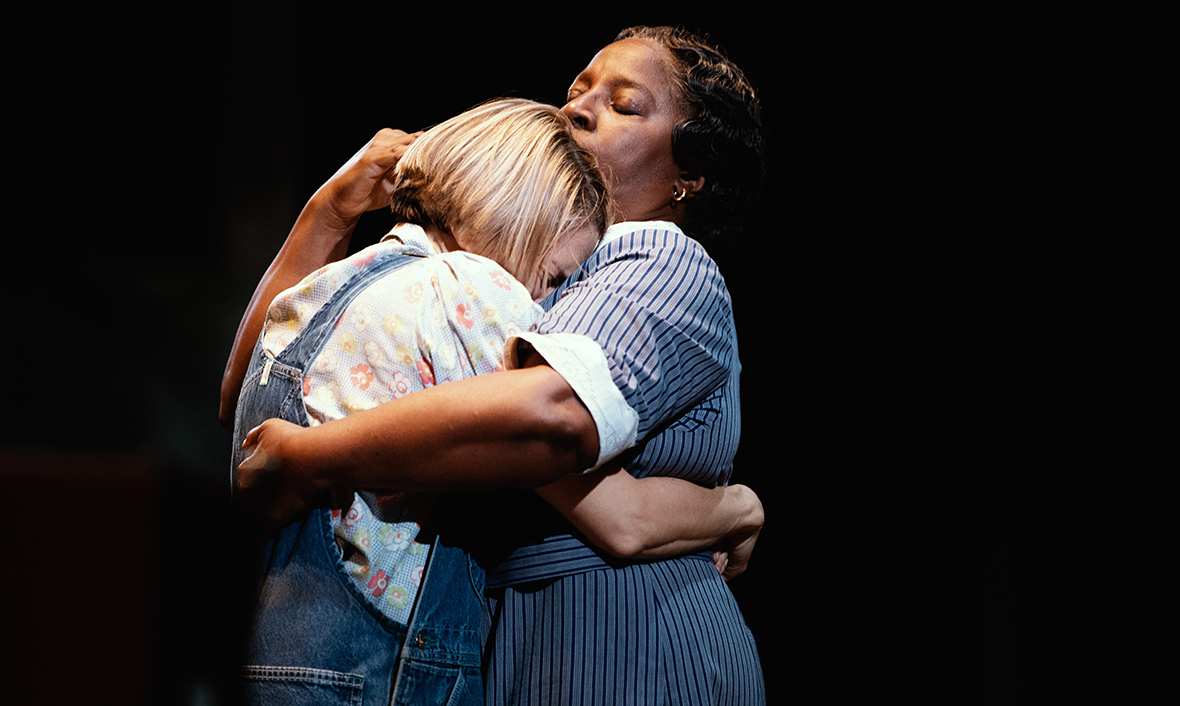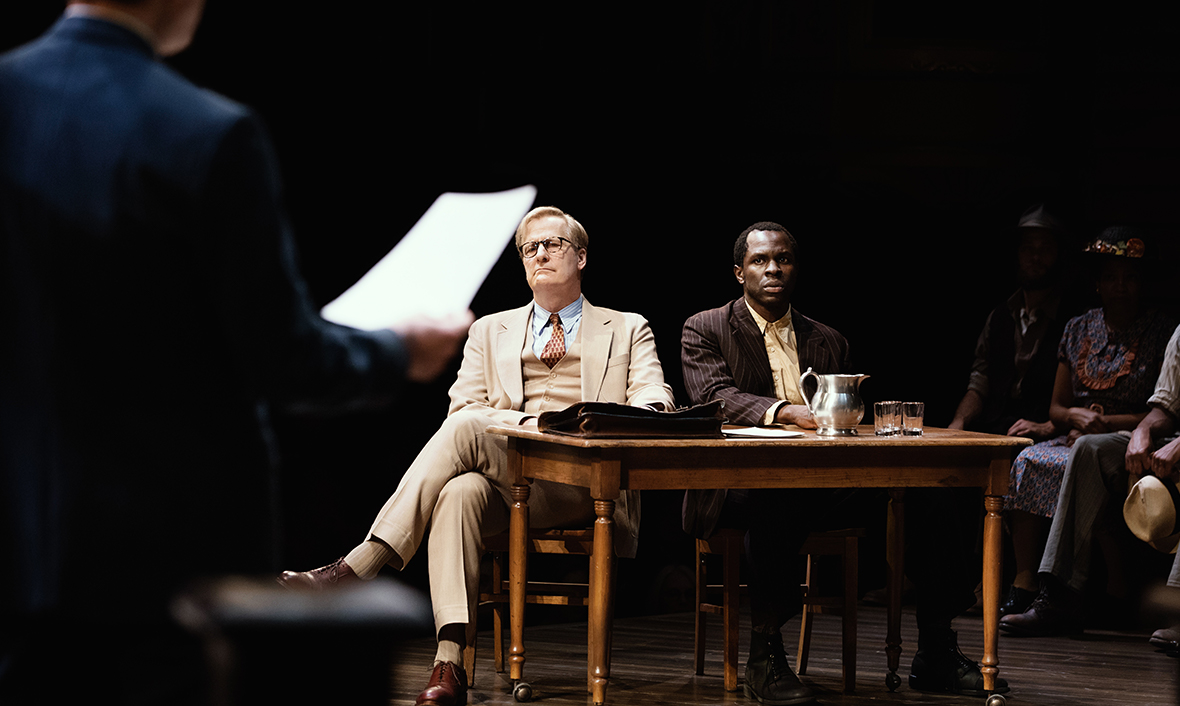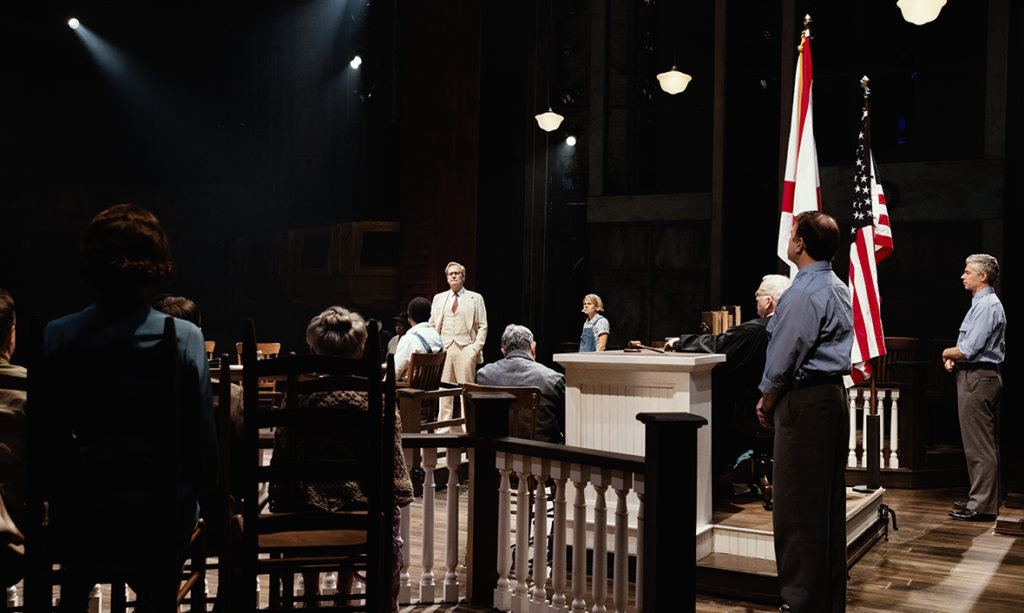Written for the stage by Aaron Sorkin, To Kill a Mockingbird (at the Shubert Theatre) opened before Christmas, yet continues to be the sensation of the Rialto. On several occasions it has sold more than $2 million worth of tickets in a single week. There are only so many seats in a theater, so arriving at that gargantuan number requires charging $500 for the best seats, $275 for good ones. Finding a same-week ticket for as little as $200 is almost impossible. Rarely, if ever, in Broadway history has a non-musical created such a sustained frenzy.
Harper Lee’s To Kill a Mockingbird (1960) is not just a classic but perhaps the classic text for the cohort that provides the biggest pool of potential Broadway ticket buyers: the affluent, well-meaning American liberals who define themselves above all other qualities as brave and righteous scourges of racism. Liberals name their children Atticus and Scout. (Well, maybe not Atticus anymore, but I’ll get to that.) On the night I attended, theatergoers were taking selfies of themselves with the set in the background, eager to show the world they bore witness to this play. Yet the Bible, Torah, and Koran of American liberalism is, at its core, illiberal. Whether told as a novel, movie, or play, the story stands for the actual opposite of what it purports to stand for. Why don’t liberals notice, or care? Because liberals don’t actually believe in liberalism. What they believe is that their side is good, and they adore having their self-image projected back at them. The dramatic and thematic flaws of the work are obvious to a rational, adult eye, but To Kill a Mockingbird is written at a child’s level, and childhood is when people tend first to encounter it. The book is therefore double-ring-fenced against clear-eyed analysis: it’s about racism, and it’s about childhood, and who are you to point out its failures, Mr. Critic, if not some kind of kid-hating racist?
Who are you to point out its failures, Mr. Critic, if not some kind of kid-hating racist?
There was a carnival atmosphere at the Shubert Theatre. Outside, a man with a small pushcart was selling buttons and other tchotchkes off a kiosk labeled “The Anti-Trump Bandwagon.” Inside the theater, the souvenir stand sold T-shirts labeled “Consent is sexy” and “Patriarchy is a bitch.” There was also a hooded sweatshirt for sale, labeled in large lettering “trayvon.” Trayvon Martin, you will recall, tackled a man who had done him no harm whatsoever and repeatedly pounded his head into the pavement. He was shot in the chest for his attack. The man who killed him, George Zimmerman, was told by police that they had security-camera footage of the whole encounter. Zimmerman’s response? “Thank God.” Police knew Zimmerman’s story was true immediately, yet prosecutors bowed to a howling mob of celebrities, pundits, and politicians and charged Zimmerman with murder. He was wrongfully put to trial, was in fact the victim of a gross injustice, because of his race. You would think the souvenir stand at a play about a race-based miscarriage of justice would be selling shirts emblazoned with the word “zimmerman.” But that would only confuse the left-wingers paying to see this play. They are here to have their tribalism affirmed. The average ticket-buyer for To Kill a Mockingbird would have been delighted to join the mob calling for a completely unjustified trial for Zimmerman, then, after his acquittal, to join the mob that formed to demand Zimmerman unjustly be retried in a federal court on the same charge, albeit with the wording on the indictment changed slightly from “murdering Trayvon Martin by shooting him in the chest” to “violating Trayvon Martin’s civil rights by shooting him in the chest.” We can be thankful that the Justice Department, unlike the mob, saw no reason to disregard the double-jeopardy clause of the Fifth Amendment. It implicitly defended the importance of procedural correctness, unlike To Kill a Mockingbird.
To Kill a Mockingbird draws a diverse audience—young white people, middle-aged white people, and elderly white people. Why were there almost zero black people in attendance in a play about a miscarriage of justice carried out against a black man in 1934 Alabama? Later I will hazard a guess. Bob Ewell (Frederick Weller), the angry and violent racist who pushes his teen daughter, Mayella (Erin Wilhelmi), to make an obviously false charge of rape and assault against the black handyman Tom Robinson (Gbenga Akinnagbe), refers to blacks as animals—but so does the criminal defense attorney Atticus Finch (played with a refreshing minimum of showboating by Jeff Daniels). Mockingbirds don’t do anything but sing their hearts out for us; that’s why it’s a sin to kill a mockingbird. Innocent, dumb, incapable of doing genuine evil: that is how we are meant to think of Tom Robinson, and by extension of black folk. Harper Lee’s racists and anti-racists alike agree that blacks are inferior to whites; they disagree merely on whether they are more like wild animals or cute pets.
Sorkin has been praised for updating the story, but he really hasn’t. The major difference is that he beefs up the character of Calpurnia (LaTanya Richardson Jackson), the black woman who has served as the family housekeeper going back generations. Sorkin has Calpurnia steer Atticus away from his view that no one, even a Klansman like Bob Ewell, is irredeemable. It seems unlikely that a black woman in Calpurnia’s position would speak her mind so freely in 1934, but what is important to Sorkin is to capture a very 2019 emotional imperative on the left—the idea that it’s crucial not merely to oppose bad things but also to make a show of anger about them, to denounce whole systems rather than just misbehaving individuals. Sorkin, who in his recent collaboration with Daniels, hbo’s series The Newsroom (2012–14), offered a running fantasy of how news programs could have covered real events in a more nakedly partisan-progressive way, has nudged To Kill a Mockingbird away from Atticus’s Southern gentility and a bit in the direction of woke columnists. In the bargain, it allows him to have a black character who does something other than suffer; Calpurnia is another stock figure, though, the wise black person bestowing enlightenment on whites.

Sorkin’s source remains what it always was: a young-adult novel, with all of the oversimplification that goes with it.
Sorkin’s source remains what it always was: a young-adult novel, with all of the oversimplification that goes with it. Sorkin does nothing to make the work more mature, more complicated for sophisticated adults. There are three kinds of people in Sorkin’s play: white racists, white anti-racists, and kindly, innocent blacks. Reducing race relations to this schema was more forgivable in 1960, when the book was published, than it is today, but then again, for white progressives, it’s still 1960. Priding themselves on their ability to weigh all the nuance and complexity in, say, human sexuality or the market economy, they adhere to a resolutely childlike vision of racial matters. Hence that trayvon hoodie: even as the disappointing facts dribbled out, the Left simply slotted the story of Martin’s demise into this pre-existing story of racist white trash (Zimmerman), white saviors (the mob clamoring for Zimmerman’s arrest), and innocent blacks in the middle. Martin, being black, could not possibly have done anything wrong. He was unarmed except for his Skittles, we were told. As if an unarmed person is incapable of committing assault. A photo of him looking like a cherub circulated widely, as if no young black male could be a criminal. Zimmerman was assigned the role of white racist because he had reported to the police a young black male, and because he had kept a wary eye on Martin. That it was perfectly understandable for a neighborhood watchman to watch the neighborhood could not be conceded by the woke mob. None of the white liberals who demanded Zimmerman be tried, then demanded he be convicted, then demanded he be re-tried, would waive the right to call the police upon sighting a suspicious stranger who happens to be a young black male. That it was racist for Zimmerman to call the police was an important fiction they told themselves (and screamed in public), a way to reassure themselves that they were so pure of heart that they would never, ever suspect an unknown young black male of anything.
Trite formulas may work fine as political slogans, but they don’t take you very far in drama. Atticus Finch would be a much more convincing hero if he were more like Lyndon Johnson—a man who did much to advance civil rights but who was also a racist who habitually referred to black Americans with the nastiest racial slurs. To Kill a Mockingbird’s characters are merely billboards for racism and anti-racism positioned around the two wonderful blacks—noble, helpful, suffering Tom and wise, soulful Calpurnia. Far from being important tutelage on the price of racism in America, To Kill a Mockingbird is mere flattery for white progressives seeking reassurance about their moral stature in the universe—at the top of the order, stalwart opponents of the white trash but also above the blacks, who are not their equals but fragile, tender mockingbirds who require white protection. To Kill a Mockingbird is a story of white liberal self-congratulation. That may be why blacks aren’t especially interested.
As a trial drama, To Kill a Mockingbird wouldn’t pass muster in the writer’s room of the most routine television courtroom saga.
A more exacting drama would work in twists and doubts: if Tom were not entirely innocent, or if there were some ambiguity about whether he had carried out the attack, the courtroom drama might be gripping. But Tom lost the use of his left arm in a cotton gin accident many years ago and couldn’t have choked Mayella with both hands nor hit her with his left fist. Somehow the citizens of the town where Tom is well known, and even the family for which Tom has repeatedly done chores, are unaware that his left arm is useless. He’s been doing work for everybody for years with one arm and nobody noticed? Preposterous. A witness who takes the stand in Tom’s defense about the arm injury is cross-examined about the defendant’s character and drinking habits to impugn his credibility, as though any of that would matter: in a burg like Maycomb, where everyone knows his neighbors, everyone would already know about poor Tom’s arm. Failing that, the mangled arm could simply be displayed to the jury. As a trial drama, To Kill a Mockingbird wouldn’t pass muster in the writer’s room of the most routine television courtroom saga.

Bob Ewell, the despicable bigot who beats up his daughter for behaving flirtatiously toward Tom, and who leads a Klan lynching party to attempt to break into the prison where Tom is being held, would be a more interesting character if he had some shred of psychological motivation for his ill will toward blacks—say, if he had been brutalized by a black man. The children in the play would have more dramatic weight if they, as products of their time, were infected with racism instead of being adorable little bonbons of childhood sweetness. (Think back to your earliest days: are kids really so sweet?) But any such adjustments that might make To Kill a Mockingbird a more effective drama would make it less like a banner of white liberal self-love, less like the narrative equivalent of a trayvon hoodie. When it emerged in Lee’s long-delayed follow-up to To Kill a Mockingbird, Go Set a Watchman (2015)—which turned out to have been written before the sanctified novel that secured Lee’s immortality but is set twenty years later—that Atticus, as late as his seventies, was actually a white supremacist, Lee’s fans were aghast and hurt. Never mind that Atticus was closely based on Lee’s own father, Amasa Coleman Lee, who was indeed a segregationist until nearly the end of his life. (Finch was her mother’s maiden name.) How dare Lee let messy reality intrude into a children’s fable about a plaster saint! How dare she introduce thorny and vexatious debate about race into their garden of race innocence! Atticus’s fifty-five-year reign as the paragon of white liberal virtue was abruptly ended. As Randall Kennedy, a black academic, wrote in The New York Times, “Go Set a Watchman demands that its readers abandon the immature sentimentality ingrained by middle school lessons about the nobility of the white savior.” To cling to immature sentimentality, though, is exactly what white progressives want. Adam Gopnik, writing in The New Yorker, seemed offended that Go Set a Watchman even exists, harrumphing that it “has not a single prefatory sentence to explain its pedigree or its history or the strange circumstance that seems to have brought it to print after all this time.” The novel is now undergoing approximately the same fate as The Godfather, Part III: fans of its predecessor are simply choosing to pretend it never appeared. Hip Brooklyn parents are not going to be naming their boys Atticus in the future, though.
Few if any of Mockingbird’s progressive fans seem to have noted that, in its final act, it contradicts itself. The core of liberalism means granting your worst enemy the same rights, the same due process, that you would grant your brother. The worst enemy here is Bob Ewell, the violent death (possibly justified) of whom at the hands of Boo Radley goes uninvestigated because everyone involved—including, after some grumbling, Atticus Finch—agrees to participate in a lie and a cover-up about the circumstances of the racist’s demise. It ought to fall to the legal process to decide whether Boo Radley is justified in killing Ewell, who is menacing the Finch children when Radley fells him with a knife. Instead, the sheriff announces he will preempt all inquiry by declaring that Ewell somehow killed himself, by falling on his own knife. A novel about the injustice of lynch mobs and race bias concludes, then, by arguing that sometimes legal procedure must be discarded in order to achieve some kind of rough justice. Ewell did great wrong to Tom Robinson, therefore he has forfeited his rights. He got what was coming to him for being a bad guy. Yet this is the same kind of tribal thinking that drives lynch mobs: forget due process, we know this guy is bad. To Kill a Mockingbird’s driving passion is not justice for all but an eye for an eye: “Let the dead bury their dead,” the sheriff says. In other words, let’s not get too hung up on whether murder was done here, it all evens out. That the reclusive, possibly mentally handicapped Boo Radley is, like Tom Robinson, described as an innocent “mockingbird” who enjoys special protection because of his intrinsically guileless nature, and cannot be judged by his actions like any other person, says much about the progressive mindset: animals, black people, and retarded people are all cast into the same basket. They’re all helpless, all in need of crusading white liberals to look out for them.
The phrase “blind spot” is the new cliché among progressive pundits who wish to call someone a racist without actually using the word, which even they must notice has a tendency to pollute the air, to render further civilized discourse unlikely. To Kill a Mockingbird represents the blindness of progressivism. It has for more than fifty years been right there in plain sight as a totem of the patronizing, condescending, dehumanizing mindset of white liberals when it comes to race. Liberals don’t see its dramatic flaws and don’t see that its final message is damning rather than reassuring. They don’t care, because what they want is a soothing balm and reassurance for their anguish about race. At the end of the performance, as I politely waited for the standing ovation to end, I noticed that many of the women around me were crying. It would never have occurred to me that such a transparent case of pandering could elicit such an emotional reaction, but then again I was left equally unstirred by the supposedly inspirational speeches of Barack Obama. People actually believed Obama was going to fundamentally transform the United States of America, to lift us to a higher level? We would become a better people by ticking the box next to his name? To Kill a Mockingbird was well ahead of the game. It proved that when you flatter white liberals with the idea that they’re holy race saviors, you can get them to believe nearly anything.

